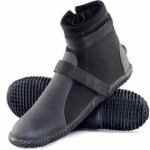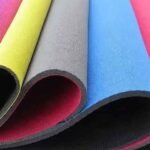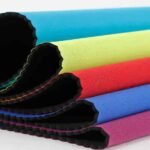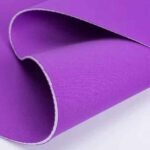Have you ever found yourself wading through icy waters or needing extra warmth during a cold outdoor adventure? Your feet play a crucial role in keeping you comfortable and protected, especially in challenging environments. Neoprene socks have emerged as a popular solution for individuals seeking enhanced foot protection and warmth during various activities. As an avid outdoor enthusiast, I’ve experienced firsthand the benefits neoprene socks offer in maintaining foot health and comfort under demanding conditions.
Neoprene socks are specialized footwear made from neoprene material, designed to provide insulation, protection, and comfort for the feet during a variety of activities, particularly in wet and cold environments.
One winter morning, while ice fishing, my standard socks couldn’t keep my feet warm and dry, leading to discomfort and reduced dexterity. Switching to neoprene socks made a significant difference, keeping my feet insulated and dry throughout the day, enhancing both my performance and enjoyment of the activity.
Transitioning from discomfort to satisfaction, let’s explore the world of neoprene socks and understand their versatile applications and benefits.
What Are Neoprene Socks?
Neoprene socks are specialized socks made from neoprene, a synthetic rubber known for its exceptional insulation and flexibility. Originally developed for wetsuits, neoprene has found versatile applications in various protective gear, including socks. These socks are designed to provide warmth, protection, and comfort in wet and cold environments, making them an essential accessory for outdoor enthusiasts and professionals alike.
Neoprene socks are insulated, waterproof socks made from neoprene material, offering enhanced warmth and protection for the feet in wet and cold conditions.
I first encountered neoprene socks during a kayaking expedition. Traditional wool socks were inadequate in keeping my feet dry and warm, leading to discomfort. Switching to neoprene socks transformed my experience, allowing me to paddle for hours without worrying about cold, wet feet.
Dive Deeper: Understanding Neoprene Material
Composition and Properties
Neoprene, or polychloroprene, is a synthetic rubber that offers excellent insulation, flexibility, and resistance to water and chemicals. Its closed-cell structure traps air, providing superior thermal insulation while preventing water from penetrating the material. This makes neoprene an ideal choice for products that require both warmth and water resistance.
Types of Neoprene Socks
Neoprene socks come in various thicknesses and styles to suit different needs:
- Standard Neoprene Socks: Offer basic insulation and waterproofing for general outdoor activities.
- Thermal Neoprene Socks: Thicker neoprene layers provide enhanced warmth for extremely cold environments.
- Reinforced Neoprene Socks: Include additional padding or reinforced areas to protect against abrasions and impacts.
- Flexible Neoprene Socks: Designed with thinner neoprene for activities that require greater foot flexibility and dexterity.
Understanding the different types of neoprene socks helps in selecting the right pair for your specific activities and environmental conditions.
What is the Point of Neoprene Wading Socks?
Neoprene wading socks are specifically designed for activities that involve walking or wading through water, such as fishing, hunting, and kayaking. The primary purpose of these socks is to provide insulation, protection, and comfort in wet environments. They keep the feet dry, warm, and protected from rough surfaces, sharp objects, and abrasive materials found in natural water bodies.
Neoprene wading socks are designed to keep feet dry and warm while providing protection against environmental hazards during water-based activities.
During a trout fishing trip, navigating through rocky streams exposed my feet to cold water and sharp rocks. Neoprene wading socks provided a comfortable barrier, preventing cuts and abrasions while maintaining warmth despite the chilly water.
Dive Deeper: Specific Features of Neoprene Wading Socks
Insulation and Warmth
Neoprene wading socks offer excellent thermal insulation by trapping a layer of air within their structure. This insulation is crucial for maintaining foot warmth in cold water, preventing heat loss, and reducing the risk of frostbite during extended periods in wet conditions.
Protection Against Abrasions
The durable neoprene material protects the feet from rough and uneven surfaces, rocks, and other abrasive elements encountered while wading. This reduces the risk of cuts, scrapes, and other injuries, ensuring a safer and more enjoyable experience.
Enhanced Comfort and Fit
Neoprene wading socks are designed to fit snugly, providing a comfortable and secure fit that prevents slipping and bunching. The flexibility of neoprene allows for a full range of motion, ensuring that your feet remain comfortable even during prolonged use.
Moisture Management
Neoprene wading socks effectively block water from penetrating, keeping the feet dry. Additionally, some models feature moisture-wicking linings that help manage sweat and prevent the buildup of moisture inside the sock, enhancing overall comfort.
Which Activities Are Neoprene Socks Best Suited For?
Neoprene socks are versatile and can be used in a variety of activities that involve water, cold environments, or the need for enhanced foot protection. Some of the most common activities suited for neoprene socks include:
- Fishing: Keeps feet dry and warm while wading through streams and rivers.
- Hunting: Provides protection and insulation during hunting trips in wet and cold conditions.
- Kayaking and Canoeing: Enhances comfort and protection during extended periods on the water.
- Surfing and Stand-Up Paddleboarding: Keeps feet warm and dry while maintaining flexibility for balance and control.
- Camping and Hiking: Offers additional warmth and protection when navigating through wet or cold terrain.
- Snow Sports: Provides thermal insulation and moisture protection during activities like skiing and snowboarding.
Neoprene socks are ideal for water-based activities, cold-weather sports, and outdoor pursuits that require foot protection and insulation.
During a snowshoeing expedition, my neoprene socks kept my feet warm and dry despite walking through deep snow and crossing icy patches, enhancing my overall comfort and performance.
Dive Deeper: Activity-Specific Benefits
Fishing and Hunting
For anglers and hunters, neoprene socks are essential for traversing wet terrains and maintaining foot warmth. They provide the necessary insulation to keep feet comfortable in cold water and offer protection from slippery and uneven surfaces, reducing the risk of injuries.
Water Sports
In water sports like surfing and paddleboarding, neoprene socks help maintain body temperature by insulating the feet from cold water. They also provide grip and protection against abrasive surfaces like rocks and coral, enhancing performance and safety.
Winter Outdoor Activities
For activities such as snowshoeing, skiing, and snowboarding, neoprene socks offer critical warmth and moisture protection. They help prevent frostbite by keeping feet insulated and dry, allowing for prolonged exposure to cold environments without discomfort.
General Outdoor Use
Beyond specific sports, neoprene socks are beneficial for any outdoor activity that involves wet or cold conditions. Whether you’re hiking through a rainy forest or camping near a cold lake, neoprene socks provide the necessary protection and comfort to keep your feet healthy and warm.
Do Neoprene Socks Go Over or Under a Wetsuit?
Neoprene socks are typically worn under a wetsuit rather than over it. Wearing neoprene socks underneath a wetsuit helps to maintain the integrity of the wetsuit by preventing direct contact between your skin and the wetsuit material, which can cause chafing or discomfort. Additionally, neoprene socks provide extra insulation and moisture management, enhancing the overall warmth and comfort of the wetsuit.
Neoprene socks should be worn under a wetsuit to provide additional insulation, prevent chafing, and manage moisture effectively.
During a scuba diving session, wearing neoprene socks under my wetsuit kept my feet warm and dry, allowing for better mobility and reducing the risk of cold-induced muscle stiffness.
Dive Deeper: Proper Layering Techniques
Layering for Optimal Insulation
Layering neoprene socks under a wetsuit maximizes insulation by creating multiple layers of protection. This setup helps trap more air between the layers, enhancing the thermal barrier and keeping your feet warmer in cold water conditions.
Preventing Chafing and Discomfort
Wearing neoprene socks under a wetsuit creates a smooth barrier between your skin and the wetsuit, reducing friction and preventing chafing during movement. This is especially important during prolonged activities where continuous motion can lead to irritation.
Moisture Management
Neoprene socks help manage moisture by wicking sweat away from the skin and preventing water from entering the wetsuit. This keeps your feet dry and comfortable, reducing the risk of blisters and other moisture-related issues.
Enhancing Fit and Comfort
Neoprene socks can improve the fit of a wetsuit by providing a snug layer that conforms to your feet, ensuring that the wetsuit sits correctly and doesn’t shift or bunch up during movement. This enhances overall comfort and performance.
Compatibility with Footwear
Neoprene socks are designed to be compatible with various types of footwear worn over a wetsuit, such as water shoes, boots, or specialized diving footwear. This compatibility ensures that you can maintain a secure and comfortable fit without sacrificing protection or flexibility.
Care and Maintenance
Proper care of neoprene socks worn under wetsuits is essential to maintain their effectiveness. Rinse them with fresh water after each use, avoid exposure to excessive heat, and store them in a cool, dry place to preserve their elasticity and waterproofing properties.
Do Neoprene Socks Keep You Warm?
Yes, neoprene socks are highly effective at keeping your feet warm in cold and wet conditions. The neoprene material provides excellent thermal insulation by trapping a layer of air within its closed-cell structure. This insulation helps maintain body heat, preventing heat loss and keeping your feet comfortable even in extreme cold environments.
Neoprene socks provide superior thermal insulation, effectively keeping your feet warm in cold and wet conditions by trapping body heat and preventing heat loss.
During a winter camping trip, my neoprene socks provided consistent warmth even when exposed to snow and cold water, allowing me to stay active and comfortable throughout the day.
Dive Deeper: The Thermal Insulation Mechanism
Closed-Cell Structure
Neoprene’s closed-cell structure is fundamental to its thermal insulation capabilities. Each cell in the neoprene fabric is sealed off, preventing air and moisture from passing through. This trapped air acts as an insulative layer, retaining body heat and shielding the feet from cold external temperatures.
Air Trapping and Thermal Barrier
The trapped air within neoprene socks forms a natural thermal barrier. Air is a poor conductor of heat, meaning it does not easily transfer temperature. By trapping air between the sock and your foot, neoprene minimizes heat loss and maintains a stable, warm environment around your feet.
Flexibility and Fit
Neoprene’s inherent flexibility allows the socks to conform snugly to the shape of your feet. This close fit ensures that the insulative layer remains effective, with minimal gaps for heat to escape. The snug fit also prevents cold air from entering and warm air from escaping, enhancing overall warmth.
Moisture Management and Heat Retention
Neoprene socks keep your feet dry by repelling water, which helps in retaining heat. Wet feet can lose heat rapidly, leading to discomfort and potential frostbite in extreme conditions. By keeping moisture out, neoprene socks maintain a dry and warm environment, ensuring that your feet stay comfortable and healthy.
Comparison with Other Insulating Materials
Compared to materials like wool or fleece, neoprene provides consistent insulation even when wet. While wool offers excellent insulation in dry conditions, its insulating properties diminish significantly when exposed to moisture. Neoprene, on the other hand, maintains its insulation capabilities regardless of moisture exposure, making it a superior choice for wet and cold environments.
| Feature | Neoprene Socks | Wool Socks | Fleece Socks |
|---|---|---|---|
| Insulation | Excellent, retains heat when wet | Excellent, but loses insulation when wet | Good, less effective when wet |
| Water Resistance | Highly waterproof | Poor, absorbs water | Moderate, absorbs some water |
| Flexibility | High flexibility, snug fit | Moderate flexibility | High flexibility |
| Comfort | Comfortable, maintains shape | Soft and comfortable | Soft and comfortable |
| Durability | Highly durable, resistant to wear | Durable, but can wear out when wet | |
| Use Cases | Water sports, cold environments | Hiking, dry outdoor activities | |
| Cost | Moderate to high | Moderate to high |
Neoprene socks offer unparalleled insulation in wet conditions, making them the preferred choice for activities where moisture and cold are constant factors.
How Do Neoprene Socks Protect Your Feet?
Neoprene socks offer comprehensive protection for your feet by combining thermal insulation, waterproofing, abrasion resistance, and impact protection. These features ensure that your feet remain comfortable, warm, and safe during various activities, particularly in challenging environments.
Neoprene socks protect your feet by providing warmth, keeping them dry, preventing abrasions, and offering cushioning against impacts and rough surfaces.
During a kayaking trip, my neoprene socks kept my feet warm and dry while protecting them from sharp rocks and abrasive surfaces, allowing me to paddle efficiently without discomfort or injury.
Dive Deeper: Comprehensive Protection Features
Thermal Insulation
Neoprene socks maintain foot warmth by trapping body heat, preventing heat loss in cold environments. This is crucial for activities that take place in chilly or wet conditions, ensuring that your feet remain comfortable and functional.
Waterproofing
The inherent waterproof properties of neoprene prevent water from entering the socks, keeping your feet dry even in submerged or wet conditions. This protection is vital for water-based activities, preventing moisture-related issues such as blisters and frostbite.
Abrasion Resistance
Neoprene’s durable material resists abrasions and wear, protecting your feet from rough surfaces, rocks, and other abrasive elements encountered during activities like hiking, fishing, and water sports. This reduces the risk of cuts, scrapes, and other injuries, ensuring a safer and more enjoyable experience.
Cushioning and Impact Protection
Neoprene provides cushioning that absorbs shocks and impacts, reducing the strain on your feet during high-impact activities. This cushioning effect enhances comfort and minimizes the risk of injuries from impacts or prolonged activity.
Enhanced Grip and Stability
Some neoprene socks feature textured soles or reinforced grips that improve traction, reducing the likelihood of slipping on wet or uneven surfaces. Enhanced grip ensures better stability and control during activities that require precise foot movements.
Chemical and UV Protection
Neoprene is resistant to various chemicals, oils, and solvents, offering protection against chemical splashes and exposure in industrial or marine environments. Additionally, neoprene’s resistance to UV rays protects your feet from sunburn and long-term skin damage during outdoor activities.
Breathability Enhancements
While neoprene is not naturally breathable, some socks incorporate breathable panels or moisture-wicking linings to manage sweat and reduce moisture buildup. This enhances overall comfort by keeping your feet dry and preventing odor accumulation.
Ergonomic Design
Neoprene socks are often designed with an ergonomic fit that contours to the shape of your feet. This design ensures a comfortable and secure fit, preventing bunching or shifting that can cause discomfort and reduce the effectiveness of the protection.
Reinforced Areas
High-wear areas such as the toes, heels, and sides of the feet are often reinforced in neoprene socks. This reinforcement enhances durability and provides additional protection against friction and abrasion in areas that are prone to wear and tear.
| Protection Feature | Description |
|---|---|
| Thermal Insulation | Keeps feet warm by trapping body heat |
| Waterproofing | Prevents water ingress, keeping feet dry |
| Abrasion Resistance | Shields feet from rough surfaces and sharp objects |
| Cushioning | Absorbs shocks and impacts, reducing strain on feet |
| Enhanced Grip | Improves traction, reducing slip risks |
| Chemical Resistance | Protects against exposure to harmful chemicals |
| UV Protection | Guards against harmful ultraviolet rays |
| Breathability Enhancements | Reduces moisture buildup, improves comfort |
| Ergonomic Design | Provides a comfortable and secure fit |
| Reinforced Areas | Adds durability and extra protection in high-wear zones |
These protective features ensure that neoprene socks offer comprehensive foot protection, making them suitable for a wide range of demanding activities.
Are Neoprene Socks Comfortable for Everyday Use?
Yes, neoprene socks can be comfortable for everyday use, especially for individuals who spend time in environments where their feet are exposed to moisture or cold. While neoprene socks are primarily designed for specific activities, their unique material properties can also provide comfort and protection in daily scenarios.
Neoprene socks offer comfort and protection in everyday settings, particularly in wet or cold environments, thanks to their flexible and insulating material.
During a rainy day commute, wearing neoprene socks kept my feet dry and warm, enhancing overall comfort without feeling bulky or restrictive.
Dive Deeper: Factors Contributing to Comfort in Everyday Use
Flexibility and Fit
Neoprene’s inherent flexibility allows the socks to conform snugly to the shape of your feet, providing a comfortable fit that doesn’t restrict movement. This adaptability ensures that the socks remain comfortable throughout the day, without causing constriction or discomfort.
Lightweight Design
Neoprene socks are generally lightweight, making them easy to wear with a variety of footwear, including sneakers, boots, and casual shoes. Their lightweight nature ensures that they do not add unnecessary bulk, enhancing overall comfort for extended wear.
Softness and Texture
High-quality neoprene socks feature a soft and smooth texture that feels gentle against the skin. This softness contributes to overall comfort, reducing the risk of irritation or chafing during prolonged use.
Temperature Regulation
Neoprene’s insulating properties help maintain a comfortable temperature by keeping feet warm in cold conditions and preventing overheating in moderate environments. This temperature regulation ensures that your feet remain comfortable regardless of the external weather conditions.
Moisture Management
Neoprene socks effectively manage moisture by keeping feet dry. This is particularly beneficial for individuals who are on their feet for long periods or engage in activities that cause sweating, as it helps prevent discomfort and odor buildup.
Easy Maintenance
Neoprene socks are easy to clean and maintain, making them a practical choice for daily use. Their durability ensures that they remain in good condition despite frequent washing and wearing, providing consistent comfort over time.
Versatility in Style
Neoprene socks come in various colors and designs, allowing you to choose styles that match your personal preferences and everyday attire. This versatility makes them a stylish and functional addition to your daily wardrobe.
Breathability Enhancements
Some neoprene socks incorporate breathable linings or ventilation features that enhance comfort by allowing air circulation and reducing moisture buildup. These enhancements make neoprene socks more suitable for extended daily wear, ensuring your feet stay fresh and comfortable.
Ergonomic Design
Neoprene socks are often designed with an ergonomic fit that contours to the shape of your feet. This design ensures a comfortable and secure fit, preventing bunching or shifting that can cause discomfort and reduce the effectiveness of the protection.
| Comfort Factor | Description |
|---|---|
| Flexibility and Fit | Conforms to foot shape, providing a snug and comfortable fit |
| Lightweight Design | Easy to wear with various types of footwear |
| Softness and Texture | Gentle against the skin, reducing irritation and chafing |
| Temperature Regulation | Maintains comfortable foot temperature |
| Moisture Management | Keeps feet dry, preventing discomfort and odor |
| Easy Maintenance | Durable and easy to clean, suitable for daily wear |
| Versatility in Style | Available in various colors and designs |
| Breathability Enhancements | Features that promote air circulation and reduce moisture |
| Ergonomic Design | Provides a comfortable and secure fit |
These factors collectively contribute to the comfort of neoprene socks, making them a viable option for everyday use, especially in environments where foot protection and warmth are desired.
Conclusion
Neoprene socks are a versatile and highly effective solution for individuals seeking enhanced foot protection and warmth during various activities. Their superior insulation, waterproofing, durability, and comprehensive protection features make them an ideal choice for water-based sports, outdoor adventures, and even everyday use in wet and cold environments. Compared to traditional sock materials, neoprene socks offer unmatched performance in maintaining foot comfort and health, especially in challenging conditions.
Whether you’re an avid fisherman, a winter sports enthusiast, or someone who simply wants to keep their feet dry and warm during rainy commutes, neoprene socks provide the necessary benefits to meet your needs. Their ability to retain heat even when wet, combined with their durable and protective nature, ensures that your feet remain comfortable and safe in a variety of environments.
At Szoneier, we specialize in manufacturing high-quality neoprene products, including neoprene socks, designed to meet diverse needs. With our 20 advanced production lines, we ensure that each pair of socks meets stringent quality standards while offering customizable options to suit your specific requirements. Our neoprene socks are durable, finely textured, soft, highly elastic, shock-resistant, thermally insulating, waterproof, and available in various designs, colors, sizes, and packaging options. We cater to B2B, wholesale, OEM, and ODM models, primarily exporting to Europe, North America, and Australia.
Whether you are a brand owner, wholesaler, importer, or design firm, Szoneier is equipped to provide you with reliable and high-quality neoprene socks that enhance protection, comfort, and brand visibility. Our low minimum order quantities and flexible customization options make it easy for you to get started. Additionally, we offer free samples and color cards to help you make informed decisions.
If you are looking for a dependable partner for your custom neoprene sock needs, don’t hesitate to reach out to us. Contact us at info@neoprene-bag.com or visit our website www.neoprene-bag.com to request free samples and color cards. Let Szoneier help you create neoprene socks that not only meet your protective and comfort requirements but also reflect your brand’s unique identity and values.











